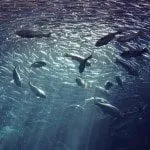Just as we are amazed at how much life can be found in a bowl of ocean water, you’d be surprised how much you could find in a scoop of mud.
It’s down IN the mud that we’re going, in our last investigation of life at the bottom of the food chain.
First, the mud that is the key to the health, and perhaps even the survival of the lagoon and all of the amazing creatures that dwell in it.
This team of Smithsonian scientists is on a mud-gathering expedition. Their leader is Bjorn Tunberg, an expert of sorts in all things muddy.
Every three months, his group visits the same 29 locations, up and down the lagoon, and collects samples of the lagoon floor, along with all the plants and tiny animals that live in it. What they are really doing, is giving the lagoon a medical check-up. It’s the mud-dwelling creatures that provide the clearest diagnosis of the impact of human pollution, because they can’t easily escape it by simply swimming away.
We can see which animals have disappeared, and which animals are still there. And so, if you find lots of pollution-tolerant species, we know that this area has just been exposed to a certain type of pollution.
The samples are preserved in formalin, combined with a chemical that turns animal tissue pink.
As they sort through everything they have collected, under microscopes, they can spot and pick out the pink, tiny creatures.
There is a whole different world of creates in these bottom-dwelling communities. They have found as many as 1,000 individual animals from 60 different species in a single scoop of mud!
We are talking about 600 species here. You can find anything from crabs to fish to worms. Most of the animals that we find are pretty small.
It’s hard to get people excited about the lagoon bottom, but the health of the tiny creatures who live there is linked to the health of the entire lagoon, and everything else living in it!
Many bottom-foraging fish, for example, they are totally dependent on this fauna. It’s their main food source. If the food source disappears, the fish disappear. It’s very important for the food chain.
The food chain starts in the mud. It leads all the way up, species by species, to the fish we eat at the dinner table. Just as the loss of big fish causes a domino effect down through the food chain, the absence of the mud dwellers has the same affect upwards.
What’s it like to be at the bottom of the food chain, where the odds of survival are 1 in 20,000? Immerse yourself in a world of mud dwellers, bottom foragers, algae-eaters and expert predators all fighting for survival in Florida’s Indian River Lagoon. Host Peter Schriemer takes you on a journey through this 156-mile inland waterway where Smithsonian biologists are working to unlock the secrets of a hidden world. What they learn will help us better understand how to protect and preserve this aquatic wonder.





